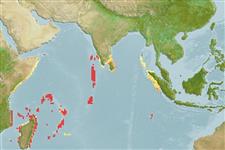Issue
The species has been synonymized with Cephalopholis urodeta (Forster, 1801) for a long time (e.g., Ref. 4787, Ref. 5222).
Environment: milieu / climate zone / depth range / distribution range
Ecologia
marino associati a barriera corallina; distribuzione batimetrica 0 - 60 m (Ref. 89707), usually 0 - 15 m (Ref. 89707). Tropical; 12°N - 39°S, 40°E - 100°E (Ref. 89707)
Indian Ocean: From East coast of Africa (Kenay to South Africa) to Sumatra; Comoros Is., Mascarene Is., Maldives, Sri Lanka, Chagos I.
Size / Peso / Age
Maturity: Lm ? range ? - ? cm
Max length : 28.0 cm TL maschio/sesso non determinato; (Ref. 89707)
Short description
Chiavi di identificazione | Morfologia | Morfometria
Spine dorsali (totale) : 9; Raggi dorsali molli (totale) : 14 - 16; Spine anali: 3; Raggi anali molli: 8 - 9. Characterized by red color grading to dark brown on posterior part of the body; posterior edge of operculum with prominent brown "ear" spot; body scales ctenoid, including abdomen; greatest depth of body 2.7-3.1 in SL; rounded caudal fin; pelvic fins 1.8-2.2 in head length (Ref. 90102); interorbital area convex; rounded preopercle, finely serrate, lower edge fleshy; subopercle and interopercle usually smooth; maxilla reaching well past eye (Ref. 089707).
Common throughout its range, the species inhabits coral-rich areas. It feeds on small fishes and crustaceans (Ref. 89707). Solitary (Ref 90102).
Life cycle and mating behavior
Maturità | Riproduzione | Deposizione | Uova | Fecundity | Larve
Craig, M.T., YJ. Sadovy de Mitcheson and P.C. Heemstra, 2011. Groupers of the world: a field and market guide. North America: CRC Press/Taylor and Francis Group. 356 p. (Ref. 89707)
IUCN Red List Status (Ref. 130435: Version 2024-1)
Threat to humans
Harmless
Human uses
Strumenti
Special reports
Download XML
Fonti Internet
Estimates based on models
Preferred temperature (Ref.
123201): 26.1 - 29.2, mean 27.7 °C (based on 294 cells).
Phylogenetic diversity index (Ref.
82804): PD
50 = 0.5000 [Uniqueness, from 0.5 = low to 2.0 = high].
Bayesian length-weight: a=0.01259 (0.00587 - 0.02699), b=3.04 (2.87 - 3.21), in cm total length, based on LWR estimates for this Genus-body shape (Ref.
93245).
Trophic level (Ref.
69278): 4.0 ±0.7 se; based on size and trophs of closest relatives
Resilienza (Ref.
120179): Medio, tempo minimo di raddoppiamento della popolazione 1.4 - 4.4 anni (Preliminary K or Fecundity.).
Fishing Vulnerability (Ref.
59153): Low vulnerability (18 of 100).
Nutrients (Ref.
124155): Calcium = 58.8 [34.6, 105.4] mg/100g; Iron = 0.603 [0.343, 1.113] mg/100g; Protein = 18.5 [16.7, 20.1] %; Omega3 = 0.177 [0.111, 0.280] g/100g; Selenium = 33.2 [18.0, 55.8] μg/100g; VitaminA = 190 [70, 606] μg/100g; Zinc = 0.847 [0.610, 1.370] mg/100g (wet weight);
